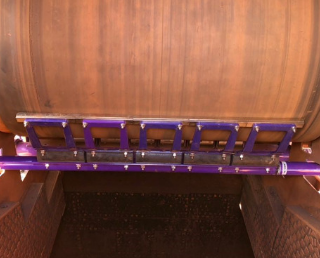Why You Should Replace Your Ineffective Belt Cleaner Right Now
I’ve never met anyone who said their conveyor belts were perfectly clean and they had no need for belt cleaners. In fact, the cleaning of conveyor belts is usually one of the most important issues on site.
That’s because efficient belt cleaning is key to optimizing the performance of your conveyor system. Clean conveyor belts last longer and help to reduce costs and downtime for repairs or maintenance on the entire system. Thorough belt cleaning also increases system productivity, safety, and employee satisfaction.
 Are all belt cleaners the same?
Are all belt cleaners the same?
Absolutely not! Belt cleaner (or belt scraper) design varies greatly – from simple homemade devices to sophisticated models designed for specific needs, applications, or industries.
Precleaners (or primary cleaners) are designed to work where the belt passes over the head pulley and below the material flow. It should remove a majority of carryback, ideal for large pieces of material and about 60-70 percent of initial carryback.
Secondary cleaners, located just past where the belt leaves the head pulley and anywhere else down the beltline, provide additional cleaning. They are especially good at removing fines, increasing cleaning efficiency to 90+ percent.
Different blades also offer different levels of compatibility with mechanical and vulcanized splices. If you want to read more about the different types of belt cleaner blades available and when you should use them, I wrote about both tungsten carbide blades and urethane blades.
Why do conveyors need belt cleaners?
Because a thoroughly cleaned and maintained conveyor system can reliably operate at 90% or higher availability. Plus, when belt cleaners are properly cleaned and maintained, belt conveyor systems can be kept to less than 2% unplanned outages due to mechanical or electrical failures. And when your belt is up and running productively at this rate, it translates into less downtime and higher production. Imagine if clean up or downtime could be converted to something more useful like preventative maintenance as demonstrated in this example.
According to an extensive study conducted at coal handling facilities in India, facilities that use cleaners required only 50% of the maintenance necessary than at facilities without cleaners. Interestingly enough, they also experienced an average of 150% longer belt life.
Problems caused by ineffective belt cleaners
When your system is running with belt cleaners that aren’t up to the job, many problems can occur.
An ineffective cleaner leaves a conveyor system vulnerable to carryback, resulting in product loss, additional labor hours on clean up and maintenance, unscheduled downtime, increased wear on the belt and other system components, and increased safety risks. Here is an example from a customer that previously spent hours on dangerous cleanup from carryback, but was able to dramatically reduce maintenance time and manpower.
Without effective cleaners, conveyors experience unchecked carryback. Fugitive material is released all along the conveyor, so clean up must be done along the entire length of the system. This increases man hours, downtime, and risks. In fact, according to the Mine Safety and Health Administration (MSHA) in the USA, 39% of conveyor related accidents occurred while cleaning or shoveling around the conveyors. Read about how a customer previously had material raining down on vehicles prior to solving their carryback issues by installing a belt cleaner, and how it improved carryback by 90%.
Carryback also causes the conveyor belt, belt splices, and conveyor idlers to experience excessive and premature wear, shortening their life and increasing downtime and costs. Once the buildup occurs, the damage is typically already done, but properly selected, installed, and maintained cleaning solutions can prevent this from ever occurring as it did at this sand and gravel site.
 The key to effective belt cleaning
The key to effective belt cleaning
Many applications will require more than one belt cleaner to do a satisfactory cleaning job. A typical system includes a precleaner, one or more secondary cleaners, and many times, a final specialty cleaner for water removal. Much of this depends on the severity of the application and the customer expectation for a clean belt. In some cases, a three cleaner system is exactly what the customer needs and often pays for itself when you look at the extra costs associated with clean-up like it did on this site.
The key to good belt cleaning is proper cleaner selection for the application, correct installation, and regular inspection or maintenance. Partner with your local Flexco team to select the right belt cleaning products and get the best possible performance from your operation.
You can request an onsite assessment of your belt cleaners, or your entire conveyor system and our application specialists can help you select the most effective belt cleaners for your unique situation. It might help you decrease downtime and increase your productivity on site.
Authored by: Kevin Fales, Product Manager
Fales manages the belt conveyor product (BCP) line, providing product development and engineering with guidance on market requirements for both new product concepts and existing products. He also leads the development of technical and promotional literature supporting BCP line. Fales graduated from Grand Valley State University with a bachelor’s degree in Marketing and is currently working toward his master’s degree in business administration from Western Michigan University.
Subscribe to the Flexco Blog
Related Blogs
Published Date
December 26, 2018Product Group
- Belt Cleaning Systems
Issues
- Belt Protection
- Belt Wear
- Blade Life
- Carryback
- Downtime
- Maintenance
- Product Loss